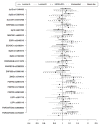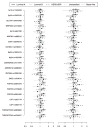Breast cancer subtypes and previously established genetic risk factors: a bayesian approach
- PMID: 24177593
- PMCID: PMC3947131
- DOI: 10.1158/1055-9965.EPI-13-0463
Breast cancer subtypes and previously established genetic risk factors: a bayesian approach
Abstract
Background: Gene expression analyses indicate that breast cancer is a heterogeneous disease with at least five immunohistologic subtypes. Despite growing evidence that these subtypes are etiologically and prognostically distinct, few studies have investigated whether they have divergent genetic risk factors. To help fill in this gap in our understanding, we examined associations between breast cancer subtypes and previously established susceptibility loci among white and African-American women in the Carolina Breast Cancer Study.
Methods: We used Bayesian polytomous logistic regression to estimate ORs and 95% posterior intervals for the association between each of 78 single nucleotide polymorphisms (SNP) and five breast cancer subtypes. Subtypes were defined using five immunohistochemical markers: estrogen receptors (ER), progesterone receptors (PR), human epidermal growth factor receptors 1 and 2 (HER1/2), and cytokeratin (CK) 5/6.
Results: Several SNPs in TNRC9/TOX3 were associated with luminal A (ER/PR+, HER2-) or basal-like breast cancer (ER-, PR-, HER2-, HER1, or CK 5/6+), and one SNP (rs3104746) was associated with both. SNPs in FGFR2 were associated with luminal A, luminal B (ER/PR+, HER2+), or HER2+/ER- disease, but none were associated with basal-like disease. We also observed subtype differences in the effects of SNPs in 2q35, 4p, TLR1, MAP3K1, ESR1, CDKN2A/B, ANKRD16, and ZM1Z1.
Conclusion and impact: We found evidence that genetic risk factors for breast cancer vary by subtype and further clarified the role of several key susceptibility genes. .
Conflict of interest statement
The authors have no financial or nonfinancial conflicts of interest to declare.
Figures
Similar articles
-
Replication of breast cancer susceptibility loci in whites and African Americans using a Bayesian approach.Am J Epidemiol. 2014 Feb 1;179(3):382-94. doi: 10.1093/aje/kwt258. Epub 2013 Nov 10. Am J Epidemiol. 2014. PMID: 24218030 Free PMC article.
-
Genetic susceptibility loci for subtypes of breast cancer in an African American population.Cancer Epidemiol Biomarkers Prev. 2013 Jan;22(1):127-34. doi: 10.1158/1055-9965.EPI-12-0769. Epub 2012 Nov 7. Cancer Epidemiol Biomarkers Prev. 2013. PMID: 23136140 Free PMC article.
-
Common genetic variants associated with breast cancer in Korean women and differential susceptibility according to intrinsic subtype.Cancer Epidemiol Biomarkers Prev. 2011 May;20(5):793-8. doi: 10.1158/1055-9965.EPI-10-1282. Epub 2011 Mar 17. Cancer Epidemiol Biomarkers Prev. 2011. PMID: 21415360
-
Genetic susceptibility loci for breast cancer by estrogen receptor status.Clin Cancer Res. 2008 Dec 15;14(24):8000-9. doi: 10.1158/1078-0432.CCR-08-0975. Clin Cancer Res. 2008. PMID: 19088016 Free PMC article. Review.
-
Disparities in breast cancer and african ancestry: a global perspective.Breast J. 2015 Mar-Apr;21(2):133-9. doi: 10.1111/tbj.12369. Epub 2015 Jan 9. Breast J. 2015. PMID: 25639288 Review.
Cited by
-
Genome-wide association study identifies new susceptible loci of IgA nephropathy in Koreans.BMC Med Genomics. 2019 Aug 19;12(1):122. doi: 10.1186/s12920-019-0568-6. BMC Med Genomics. 2019. PMID: 31426789 Free PMC article.
-
SNP variants at the MAP3K1/SETD9 locus 5q11.2 associate with somatic PIK3CA variants in breast cancers.Eur J Hum Genet. 2017 Feb;25(3):384-387. doi: 10.1038/ejhg.2016.179. Epub 2016 Dec 28. Eur J Hum Genet. 2017. PMID: 28029147 Free PMC article.
-
FGFR2 risk SNPs confer breast cancer risk by augmenting oestrogen responsiveness.Carcinogenesis. 2016 Aug;37(8):741-750. doi: 10.1093/carcin/bgw065. Epub 2016 May 28. Carcinogenesis. 2016. PMID: 27236187 Free PMC article.
-
Association of ESR1 germline variants with TP53 somatic variants in breast tumors in a genome-wide study.medRxiv [Preprint]. 2023 Dec 6:2023.12.06.23299442. doi: 10.1101/2023.12.06.23299442. medRxiv. 2023. Update in: Cancer Res Commun. 2024 Jun 27;4(6):1597-1608. doi: 10.1158/2767-9764.CRC-24-0026. PMID: 38106140 Free PMC article. Updated. Preprint.
-
Association Study Confirmed Three Breast Cancer-Specific Molecular Subtype-Associated Susceptibility Loci in Chinese Han Women.Oncologist. 2017 Aug;22(8):890-894. doi: 10.1634/theoncologist.2016-0423. Epub 2017 Apr 13. Oncologist. 2017. PMID: 28408616 Free PMC article.
References
-
- Livasy CA, Perou CM, Karaca G, Cowan DW, Maia D, Jackson S, et al. Identification of a basal-like subtype of breast ductal carcinoma in situ. Hum Pathol. 2007;38:197–204. - PubMed
-
- Melchor L, Benítez J. An integrative hypothesis about the origin and development of sporadic and familial breast cancer subtypes. Carcinogenesis. 2008;29:1475–82. - PubMed
-
- Althuis MD, Fergenbaum JH, Garcia-Closas M, Brinton LA, Madigan MP, Sherman ME. Etiology of hormone receptor-defined breast cancer: a systematic review of the literature. Cancer Epidemiol Biomarkers Prev. 2004;13:1558–68. - PubMed
Publication types
MeSH terms
Grants and funding
LinkOut - more resources
Full Text Sources
Other Literature Sources
Medical
Research Materials
Miscellaneous



